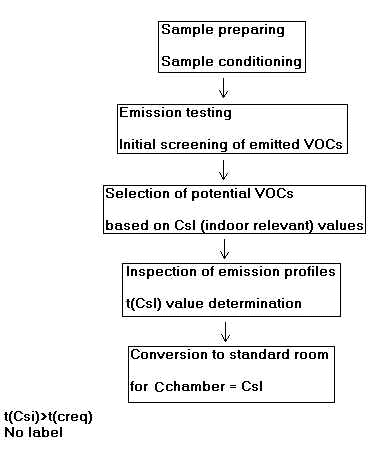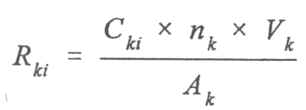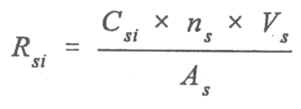[Front page] [Contents] [Previous] [Next] |
Emission of Volatile Oganic Compounds from Wood and Wood-Based Materials
Appendix 4: General Principles for Evaluation Based on Indoor-Relevant Time-ValuesThis Appendix gives a description of an evaluation of emissions based on indoor-relevant time-values as used in the Indoor Climate Labelling concept, described by Danish Society of Indoor Climate, DSIC, for documentation and labelling of the influence from building products, furniture and other products used indoors.
The basis of the concept is an indoor-relevant time-value based on chemical measurements of primary source emission of VOC's and on sensory evaluation.
The documentation and labelling concerns the indoor air properties, which a new product is expected to have, when it is installed in the building. According to the DSIC the indoor-relevant time-value has to be accompanied by indoor related guidelines for storage, transportation, installation, use, cleaning, maintenance etc. in order to describe a possible impact of the product on the indoor air during the total period of use. The chemical measurements of the VOC emission is based on a determination of individual chemical substances. When the indoor-relevant time-value is determined from the chemical analyses a sensory evaluation of the acceptability and intensity of the air is carried out at the time corresponding to the time-value based on chemical testing. The sensory determination is used as a total and supplementary determination of the air quality.
However, within this project the evaluation has been restricted to source emission determined by chemical analyses besides informative sensory determination of three materials.
A summary of procedures for testing and evaluation carried out within this project are given below. The total concept is given in DSIC ref. 1-3.

Csi: Concentration of VOCi in standard room
t(Csi): Indoor-relevant time-value
t(Creq): The maximum allowable time-value for labelling
The indoor-relevant time-value is defined as the time it takes to reach down on a defined acceptable concentration of the indoor climate in a standard room under standard conditions.
To phrase it popularly the indoor-relevant time-value is the time it takes from a product is installed till the emissions of all single substances are down at an acceptable concentration in the indoor air - based on odour and mucous irritation thresholds and standard room considerations. A declared time-value of, for example, 10 days means that the probability of the product to cause odour or to cause irritation in eyes, nose and upper respiratory passage is insignificant later than 10 days after installation of the product.
The result given as a single indoor-relevant time-value is determined by converting chamber concentrations measured by chemical analyses to concentrations in a standard room and compared with odour thresholds and mucous membrane irritation thresholds.
When generally accepted indoor air threshold values concerning carcinogenic and allergenic effects are defined, these health effects will be included.
Descriptions and calculations in more details are given below and in Atest method for determination of emission from building products" (DSIC1). Additional information on the technical background, assumptions, limitations and indoor comfort evaluation is given in (DSIC2), (DSIC3) and (DSIC4).
Principle in Determination of the Indoor-Relevant Time-Value
The determination of the indoor-relevant time-value of a product is based on the time, it takes the slowest emitting individual chemical substance with the lowest indoor-relevant odour or irritation threshold to reach half of this value in a fictive standard room (DSIC5) and (DSIC6).
The standard room used for general calculations of indoor air concentrations has a relatively large surface area compared to the room volume, see last part of "conversion of concentrations from test chamber to air in standard room".
In the example shown below, VOC2 showed to be the slowest emitting single substance, and to have an odour threshold value, which is lower than the irritation threhold value. The time-value corresponding to 50% of the threshold value based on VOC2 was found to be 28 days from the crossing of emission profile curve of VOC2 converted to standard room concentration and half of the odour threshold value line. The product was given a declared time-value of 30 days.
Air quality comfort thresholds for more than 800 chemical substances as well as other physio-chemical parameters are given in the databank "VOCBASE" (DSIC4), which is the reference databank of the laboratories.
The odour often becomes the determining factor, as the odour thresholds generally are magnitudes lower than mucous membrane irritation thresholds and thresholds of more severe effects.
Determination of the Indoor-Relevant Time-Value based on Chemical Analyses
The determination of the indoor-relevant time-value includes the following steps:
| Result of chemical analysis of air from test chamber | |
| Conversion of concentrations from test chamber to air in standard room | |
| Calculation of indoor-relevant time-value based on chemical analyses |
Result of Chemical Analysis of Air from Test Chamber
The calculation based on results from chemical analysis of air samples collected from the test chamber is carried out according to the following procedure.
The concentration changes all the time in the test chamber, also while the sampling takes place. The concentration, Cki, measured, which is measured, is, therefore, an average value of the equilibrium concentration over the sampling time. The equilibrium concentration will in most cases change so little in time that it can be considered constant during usual sampling times, usually less than a couple of hours.
By repeated measurements the measured concentration should be given as function of the measuring time. The graduation of the axes should be adjusted to the size of the concentrations and to the size of the measuring times, the axes should start with zero.
The curve, which the points indicate, is the emission profile of the measured substance. The same test specimen may have different emission profiles for the different substances.
The concentration in the test chamber can not be compared directly with the acceptable concentration of the indoor air quality, therefore, the emission rate in the test chamber is defined in the formula below.

where:
| Rki | is the emission rate in the test chamber for the compound "i", µg/(m2•h) or mg/(m2•h) | |
| Cki | is the concentration in the test chamber of the compound "i", µg/m3 or mg/m3 | |
| nk | is the air exchange rate in the test chamber, h-1 | |
| Vk | is the volume of the test chamber, m3 | |
| Ak | is the test specimen's exposed area in the test chamber, m2 |
The area divided by the volume is called the material loading.
Conversion of Concentrations from Test Chamber to Air in Standard Room
The concentration measured in the test chamber should be converted to a concentration in a fictive standard room representing the indoor air quality. It is assumed that the emission rate is the same in the test chamber as in the standard room, which implies that the test chambers used give completely uniform concentration conditions.
The emission rate in the standard room is defined below:

where:
| Rsi | is the emission rate in the standard room for the compound "i", µg/(m2•h) or mg/(m2•h) | |
| Csi | is the concentration in the standard room of the compound "i", µg/m3 or mg/m3 | |
| ns | is the air exchange rate in the standard room, h-1 | |
| Vs | is the volume of the standard room, m3 | |
| As | is the building material's exposed area in the standard room, m2 |
Furthermore, the definition is valid:
| This approximately will to a great extent apply to e.g. most semi-hard materials |
Accordingly, the concentration of the indoor air quality can be calculated according to the formula below:
In cases where the influence of the air temperature, the relative humidity or other factors on the emission (and thereby the concentration) are known, this influence can be included in the technical assessment.
Conversion of the results from the test chamber to indoor air quality is based on the following standard room and standard conditions (DSIC5):
| Volume of the standard room: | 17.4 m3 |
| Exposed areas in the standard room, m2 | |
| Flooring material | 7 |
| Ceiling material | 7 |
| Wall coating | 24 |
| Door surface | 2 |
| Window frame | 0.2 |
| Sealants | 0.2 |
| Fixtures | 4 |
| Total | 44.4 m2 |
When the conditions in the test chamber do not vary significantly from the requirements to the climate parametres of the standard room, the results can be used without correction.
All materials can have the same emission per m5.
Calculation of the Indoor-Relevant Time-Value Based on Chemical Analyses
The databank "VOCBASE", includes odour thresholds, OT, and irritation thresholds, IT, (DSIC4).
The acceptable concentration in the indoor air quality of one individual compound is 50% of the smallest of the values OT and IT. The acceptable concentration is calculated from the formula below:
CLi= 0.5•min {OT,IT}i
where
| CLi | is the acceptable concentration of the indoor air qualityof the compound "i", µg/m3; or mg/m3; | |
| OT | is the odour threshold, µg/m3; or mg/m3; | |
| IT | is the irritation threshold, µg/m3; or mg/m3; |
It is assumed that the irritative impact from more compounds at the same time is bigger than the irritative impact from an individual compound. When there are more compounds, which is often the case, the requirement to the concentration is made on the level of a sum of compounds and not on the level of one single compound, see the formula below. The sum formula does not apply in the case of odour.

The measured indoor-relevant time-value is given in whole days.
Evaluation of Sensory Determination
The sensory determination is used as a total and supplementary determination of the air quality. The sensory evaluation of the acceptability and intensity of the air is generally carried out at the time corresponding to the time-value based on chemical testing.
The sense of smell has receptors which are sensitive both qualitatively and quantitatively to a large number of chemical compounds. By determination the quality is referring to acceptability and the quantity is referring to the intensity.
The objective of the test is to make a sensory determination of the total emission from building products in a test chamber. The principle is that the building products in the test chamber are exposed in a constant climate corresponding to the climate in living rooms in buildings and that a representative number of test persons at specific times determine the exhaust air from the test chamber according to a given procedure.
The test chamber should be equipped with an odour diffuser allowing sensory evaluations by sniffing.
For determination an untrained panel consisting of approx. 20 persons is used. The composition of the persons in the panel should reflect the composition of persons in the society, especially, what concerns sex and smoking habits, which is assumed to influence the determination. It should be avoided to use persons, who have been working a in a strongly smelling environment. Furthermore, the persons should have the sense of smell and should not have a cold. There should be an equal distribution of sexes.
The panellists should be between 18 and 50 years of age and it should be noted whether the members of the panel are smokers or not. The persons in the panel must not emit disturbing smells and the person in charge of the test should control this. The persons must not eat nor smoke the last hour prior to the determination.
The panellists indicate their evaluations on two continuous scales regarding intensity and acceptability of the air compared to reference air:

An acceptability of "0" (just acceptable) and an odour intensity of "2" (moderate odour) can be used as the limits for acceptable air quality.
DSIC References:
- Danish Indoor Climate Labelling. Standard Test Method for Determination of Emission from Building Products (in Danish). Danish Indoor Climate Labelling Association, 1.st edition December 1994.
- Wolkoff, P. and Nielsen, P.A. Indoor Climate Labelling of Building Materials: The Experimental Approach for a Prototype, Characterizing Sources of Indoor Air Pollution and Related Sink Effects, ASTM STP 1287, American Society for Testing and Materials, 1996, pp. 331-349.
- Wolkoff, P. and Nielsen, P.A. A New Approach for Indoor Climate Labelling of Building Materials - Emission Testing, Modelling and Comfort Evaluation Atmospheric Environments, Vol. 30, 1996. pp. 2679-2689.
- Jensen, B. and Wolkoff, P. VOCBASE. Odour Thresholds, Mucous Membrane Irritation Thresholds and Physio-Chemical Parameters of Volatile Organic Compounds. Nat. Inst. Occup. Health. Denmark. 1996
- Directions for the Determination and Evaluation of the Emission from Building Products. DS/INF 90 (in Danish). Danish Standards Association. Copenhagen 1994.
- Nielsen, P.A., Jensen, L.K., Eng, K., Bastholm, P., Hugod, C., Husemoen, T., Mølhave, L. and Wolkoff, P.: Health-Related Evaluations of Building Products Based on Climate Chamber Tests, Indoor Air, Vol. 4, pp. 146-153, 1994.
[Front page] [Contents] [Previous] [Next] [Top] |